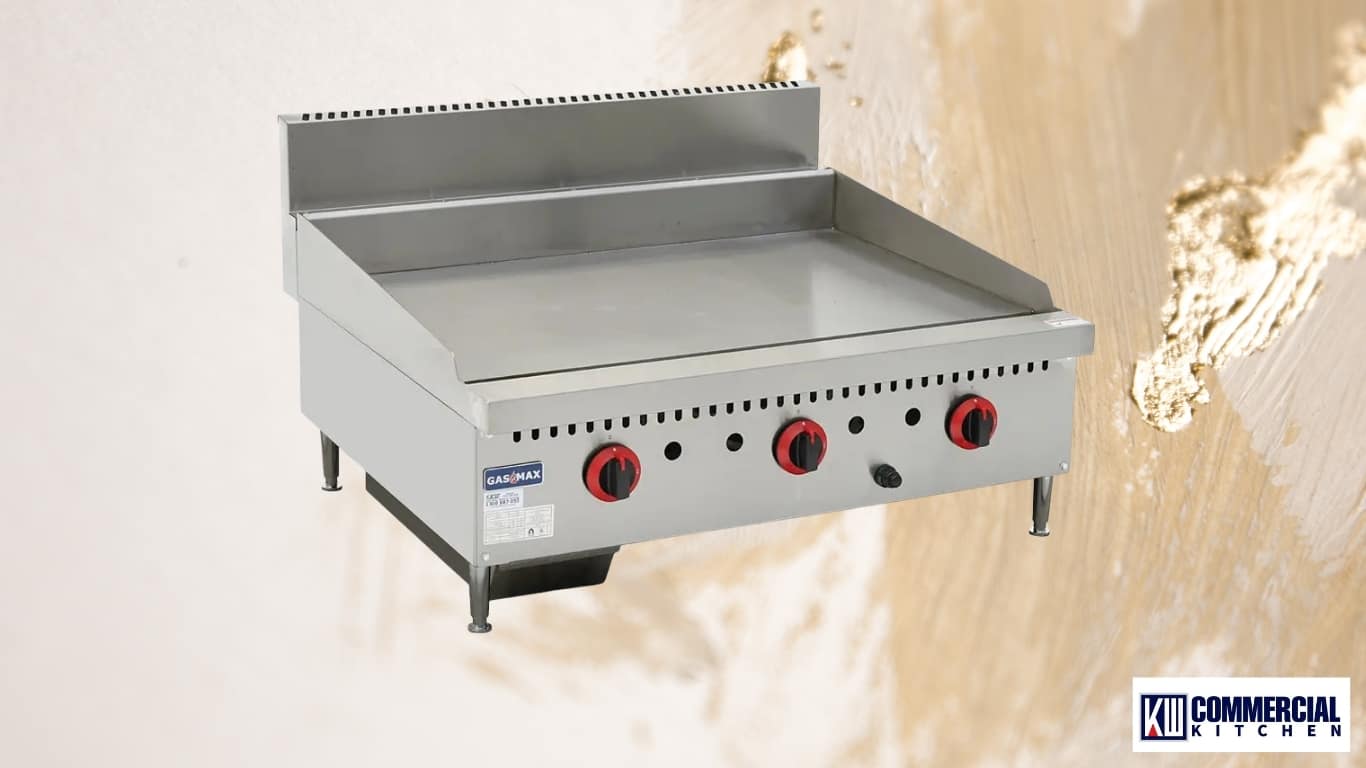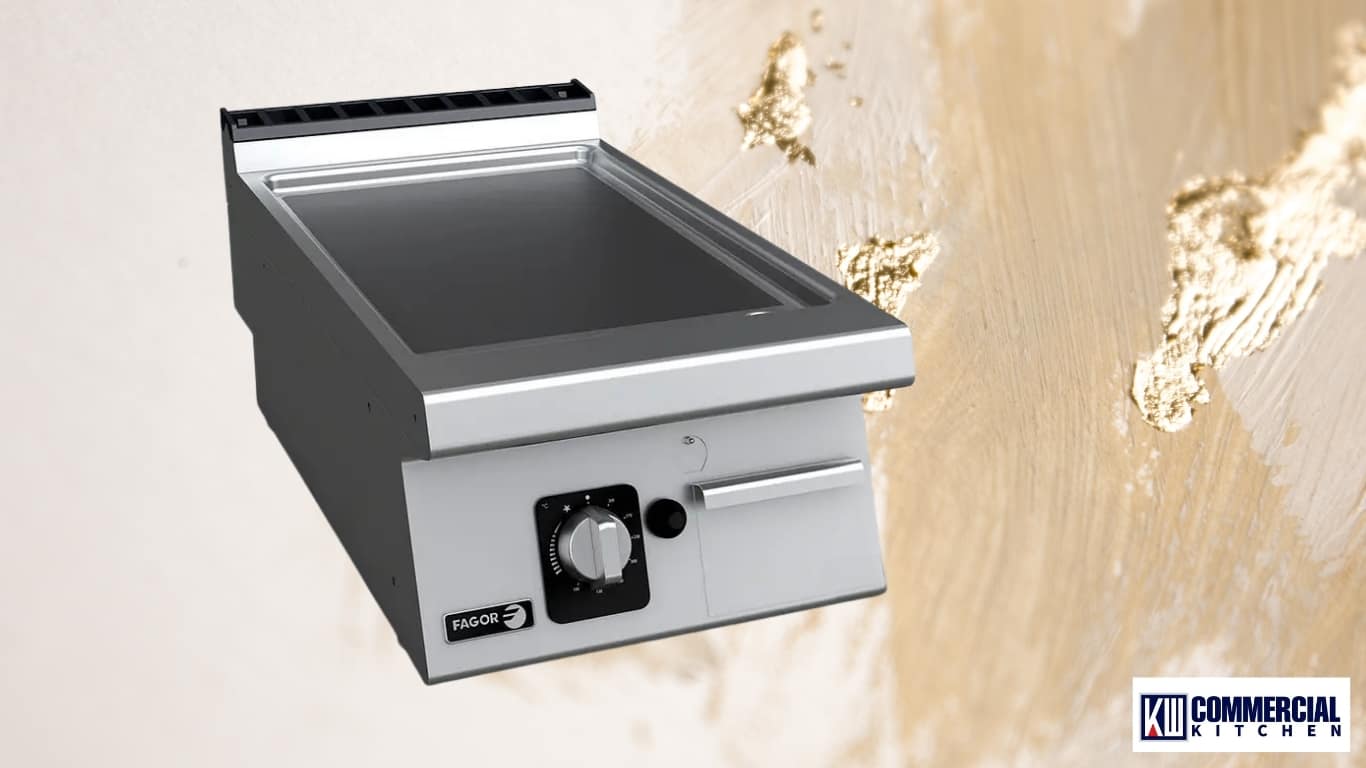What Is a Commercial Griddle? The Australian Operator’s Answer
A commercial griddle is a thick, heated flat steel plate that cooks food directly on its surface by conduction—fast, even browning at scale. It is not a char‑grill (no open bars/flame) and not a frypan. This page gives the precise definition, how to stop eggs/fish sticking, gas vs electric choices, Australian ventilation basics, and a buying checklist built for real venues.
Shop Commercial Griddles Daily Cleaning (Chemist) Steps Quick FAQ
- Best temp windows: eggs 160–175 °C; fish/seafood 180–200 °C; smash burgers 205–230 °C with a short lid/steam finish.
- Gas → ducted canopy is the default in AU. Electric griddle may be approved with a certified ductless hood only where the unit + hood package meets local Council requirements. Always verify with licensed contractors and your Council.
- Thicker plates (≥15–20 mm) cost more to preheat but hold recovery better during rushes and big frozen loads.
- Daily “Chemist” clean: warm plate → dwell → scrape → light boil with diluted chemist → final hot‑water rinse → dry; oil‑film protect for carbon steel (not chrome).
The Fundamentals
What a griddle is (and isn’t)
Griddle = heated flat plate (carbon steel or chrome‑plated) with thermostatic control in one or multiple zones. Food contacts the plate directly, creating uniform conduction heat for eggs, pancakes, burgers, fish and teppan‑style stir‑fry. A char‑grill uses open bars over a burner or charcoal; a plancha/teppan often has thinner plates and runs hotter at the edges; a frypan is a portable vessel rather than a fixed plate.
Plate materials & thickness: what actually matters
- Carbon/mild steel — affordable, durable; seasoned oil‑film helps release; can be re‑surfaced; needs thin protective oil after cleaning to prevent rust.
- Hard‑chrome — smoother surface, excellent release for eggs/fish, less radiant heat; no abrasive stones/pumice and avoid heavy scoring; follow brand care rules.
Thickness (typical 12–25 mm): thicker plates store more heat (better recovery) but take longer and cost more to preheat. Many busy cafés and burger sites settle at 15–20 mm as the sweet spot.
Mastering Your Griddle — Menu, Temperatures & No‑Stick Fixes
What a griddle cooks best (menu–temperature matrix)
The ranges below reflect common practice across AU kitchens. Always check your recipe specs, food safety plan and equipment manual.
| Food | Surface temp (°C) | Oil film | Lid/steam? | Typical cook time* | Notes to avoid sticking |
|---|---|---|---|---|---|
| Eggs (fried/sunny) | 160–175 | Thin sheen | Yes, 10–20 s to set top | 1.5–2.5 min | Plate too cool causes glue; use thin oil film, don’t flood; sharp, flat spatula. |
| Seafood (fish fillet, scallops) | 180–200 | Light oil; often oil the fish | Optional (short) | 2–4 min (thickness‑dependent) | Pat dry; flip once; chrome needs correct temps and gentle tools. |
| Smash burgers (120–150 g) | 205–230 | Very light film | Short lid for melt | 1.5–2 min/side (smash = faster) | High contact; manage smoke via hood & grease drawer schedule. |
| Pancakes / French toast | 175–190 | Light film or butter‑clarified | No | 2–3 min/side | Batter benefits from uniform plate & steady zone temp. |
| Vegetables / teppan‑style noodles | 190–210 | Light film | Optional | 3–5 min | Use two zones to stage crisping vs holding. |
*Indicative timings for planning. Your loads, plate thickness and ambient conditions will vary.

Why eggs or fish stick — and how to stop it immediately
- Temperature window: too cool = proteins glue; too hot = tear. Use the table ranges above and verify with an IR thermometer.
- Moisture control: pat seafood dry; excessive surface water flashes to steam and lifts flesh unevenly.
- Oil strategy: for delicate fish, lightly oil the protein rather than the whole plate; eggs need only a thin sheen on the surface.
- Top‑finish with a lid (cloche): 10–20 s sets the top and releases edges without over‑oiling.
- Correct tools: flat, sharp‑edged spatula; no abrasive blocks on chrome.
Daily cleaning — “Chemist” method (end‑of‑day)
- Power off / turn gas off. While the plate is still warm (not red hot), pour diluted kitchen degreaser (“chemist”) or chemist as directed. Dwell a few minutes to melt residue.
- Scrape with a flat scraper/pro griddle brush towards the grease trough; empty the drawer safely.
- Add a small amount of chemist + water, bring to a gentle boil, then scrape again.
- Rinse with hot water until completely clear (no chemical residue).
- Dry the plate. For carbon steel, wipe a very thin film of high‑smoke‑point oil for protection. Do not oil chrome.
- Wipe splashbacks, front controls and shelves; wash the scoop & store outside the grease path.
- Shock a hot plate with ice or cold water.
- Use pumice/abrasives on chrome plates.
- Leave chemical residues (rinse thoroughly).
Weekly/periodic: pull & soak baffles and the grease drawer; clean air filters and condenser fins; check gas ports/venturi; verify thermostat calibration.
Buying & Installation — Gas vs Electric, Sizing, Ventilation
Gas griddle vs electric griddle — choose in 60 seconds
| Factor | Gas griddle | Electric griddle |
|---|---|---|
| Site utilities | Requires compliant NG/LPG supply & licensed gasfitter | Requires adequate amperage; 3‑phase common for larger plates |
| Heat & recovery | Strong heat density; recovery depends on plate mass and burner layout | Very even conduction; excellent zone control; recovery also tracks plate mass |
| Ventilation | Ducted canopy expected in AU commercial kitchens | Ducted by default; some sites may seek certified ductless hoods—approval is Council‑specific |
| Cost per hour (quick maths) | Gas cost ≈ MJ/h × $/MJ | Electric cost ≈ kW × $/kWh |
| Best‑fit venues | Burger shops, pubs, high‑heat lines, existing gas canopy | Hotels, all‑electric kitchens, precise multi‑zone work, sites short on gas |
Plate widths, zones & realistic throughput
| Width & plate | Typical zones | Preheat to ~200–220 °C | Eggs (100 g) per cycle | Smash burgers (150 g) per cycle | Notes |
|---|---|---|---|---|---|
| 600 mm, 12–15 mm steel | 1–2 | 12–18 min | 8–12 | 6–8 | Compact lines; batch carefully to keep recovery stable. |
| 900 mm, 15–20 mm steel/chrome | 2–3 | 15–22 min | 16–24 | 12–16 | Common café/burger size; mix temps across zones for staging. |
| 1200 mm, 20–25 mm steel/chrome | 3 | 20–28 min | 24–36 | 18–24 | High volume; thick plate holds recovery when frozen loads hit. |
Numbers are planning ranges, not brand claims. Always confirm with your recipes, staffing and service rhythm.

Ventilation & compliance (Australia)
Short answer: treat griddles as grease‑laden appliances. In Australian commercial kitchens, gas griddles are typically installed under a ducted canopy serving capture, filtration and discharge per mechanical ventilation practices (e.g., AS 1668.2). Electric griddles are also commonly installed under ducted canopies; some projects may pursue certified ductless (recirculating) hoods, but acceptance is Council‑specific and must be confirmed in writing.
- Gas installs are performed by licensed gasfitters and must comply with gas installation requirements (e.g., AS/NZS 5601) and manufacturer clearances.
- Make‑up air, hood capture & filter maintenance matter for smoke/odour control and fire safety. Keep a cleaning log for filters and the grease drawer.
This section is practical guidance for operators. Always follow the equipment manual and engage licensed trades and your local Council for approvals.
Buying checklist (print‑friendly)
- Menu focus (eggs/seafood/burgers/teppan) and peak covers per hour.
- Gas available with compliant canopy, or adequate power (amps/phases) for electric.
- Plate material (steel vs chrome) and thickness (≥15–20 mm for peak stability).
- Width (600/900/1200 mm) and zones (1–3) for staging different temps.
- Grease management (drawer capacity, clean‑out access) and splashbacks.
- Cleaning time budget & compatible “Chemist” products (chrome care rules).
- Local service network & spare parts support.
Safety & Troubleshooting
- Gas flame “flaring/乱串” or persistent yellow flame → isolate heat, allow to cool, clean burners/ports; verify regulator and hoses; call a licensed gasfitter.
- Electric breaker trips → isolate; may indicate element/thermostat or circuit sizing issues; call an electrician.
- Grease flare → lid or fire blanket; never water; review hood filter schedule and plate oiling habits.
Frequently Asked Questions
Is a griddle the same as a flat‑top?
In commercial kitchens, the terms are often used interchangeably, but a griddle typically means a thermostatically controlled, flat plate appliance with zones. A “flat‑top” on a range is a plate heated by burners below with less precise zone control.
Can I run an electric griddle under a ductless hood?
Sometimes—only where the specific electric griddle and certified recirculating hood are accepted by your local Council. Most sites still use a ducted canopy. Confirm with your mechanical contractor and Council before you buy.
What plate thickness should I choose?
15–20 mm suits most busy cafés/burger venues: solid recovery without extreme preheat time. Lighter plates heat faster but sag during heavy frozen loads; 20–25 mm suits high‑volume rushes.
Why do my eggs tear or my fish glue to the plate?
Usually a temperature window or moisture issue. Use 160–175 °C for eggs, 180–200 °C for fish, pat proteins dry, apply a thin oil film and use a short lid‑finish to set the top.
How long does preheat actually take?
Indicatively: 12–18 min for 600 mm, 15–22 min for 900 mm, and 20–28 min for 1200 mm plates to reach ~200–220 °C, depending on thickness and environment.
What’s the correct daily cleaning process?
See the Chemist steps above: warm plate → dwell → scrape → light boil with diluted chemist → thorough hot‑water rinse → dry (oil‑protect carbon steel, not chrome).

